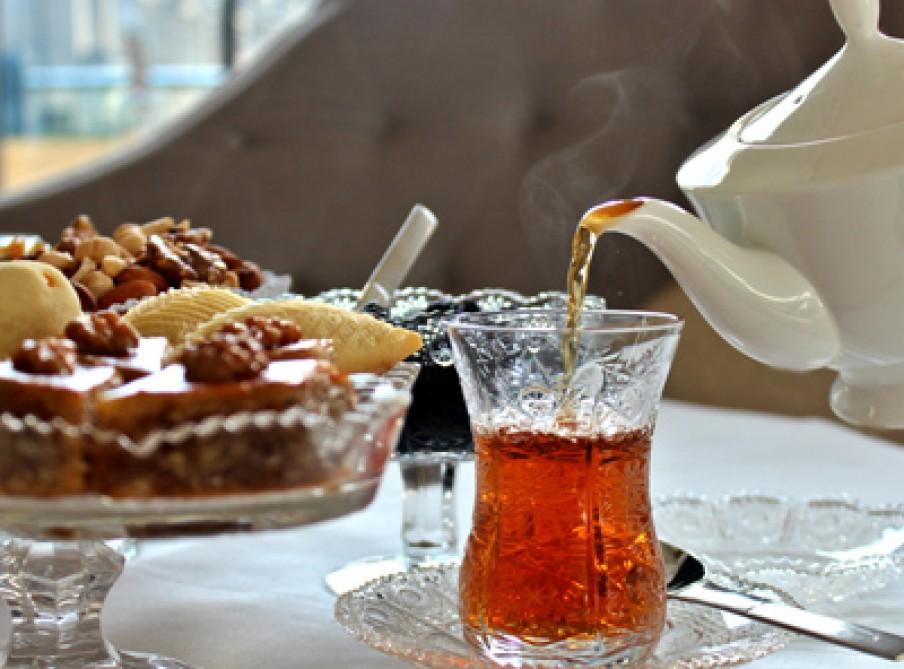Tea drinking traditions in Azerbaijan

By Laman Ismayilova
There's nothing better than a freshly brewed cup of tea. It is the second most consumed drink in the world after water. Millions of people around the world enjoy drinking tea for many reasons.
Drinking tea has many health benefits. There is plenty of research showing that drinking tea can help protect your teeth and your heart, as well as possibly even helping to stave off cancer.
Tea contains antioxidants that keep us young and protect us from damage from pollution. At the same time it helps keep you hydrated.
For many centuries tea has been widely consumed as part of traditional medicine in the Asian continent.
The history of tea dates back to ancient China, almost 5,000 years. The Chinese have consumed tea for thousands of years. Nowadays every country has their own tea drinking traditions.
There are many tea drinking traditions, customs and rituals to explore in the Land of Fire. In Azerbaijan tea is more than just a cup of tea to start the day. Azerbaijanis cannot imagine their daily life without this refreshing drink.
Drinking tea has become an essential part of Azerbaijani culture. Tea is associated with warmth and hospitality. Therefore, the tradition says that one should not allow the guest to leave the house without having at least one cup of tea.
A tea ceremony in Azerbaijan features freshly brewed, strong, bright-color, hot tea served in cups or crystal glasses, in particular, "armudu glass" i.e. "pear-shaped glass". Generally, tea is poured into ceramic dishes. Water is boiled in various ways, in particular, in heated metal containers known as samovars.
In Azerbaijan tea is served with lemon, cube sugar, fruit desserts and jams. Some popular jams are made from plums, raspberries, mulberries, pears, peaches, melons, figs, strawberries and cherries.
The legend says that drinking tea with lump sugar instead of sand sugar comes from the medieval period, when rulers who were afraid of being poisoned checked their tea by dunking a piece of sugar in a beverage.
Tea ceremonies have deep traditional roots in Azerbaijan. A traditional tea ceremony has its own rules and practices. The host has to offer tea to every visitor, even if the visit is supposed to last only five minutes.
The taste of sweet tea or unsweetened tea shows the agreement or rejection of the girl's parents to the marriage.
If the woman's parents agree that the couple should be together, they serve tea with sugar at the end of the conversation; sugar is the key ingredient symbolizing their agreement. Unsweetened tea is a sign of rejection.
Azerbaijani people may drink tea in traditional tea houses called chaykhana. Men sit in a chaykhana to pass time, playing backgammon and drinking tea.
Historically, Azerbaijani women did not go to public places, so chaykhana used to be a place for men.
In Azerbaijan tea is mainly grown in the Lankaran-Astara region. In 1934, specialists from Moscow visited Lankaran and took samples of the soil.
They analyzed the samples and found that Lankaran is one of the most fructuous areas for tea growing. Since that time, tea factories have been operating in Lankaran and neighboring regions.
Lankaran became the main area in Azerbaijan for the cultivation of rice, tea, citrus fruit and vegetables.
Tea is so popular in Lankaran, that it has tea monument beside the entry to the city – a huge samovar (tea boiler).
---
Laman Ismayilova is AzerNews’ staff journalist, follow her on Twitter: @Lam_Ismayilova
Follow us on Twitter @AzerNewsAz
Here we are to serve you with news right now. It does not cost much, but worth your attention.
Choose to support open, independent, quality journalism and subscribe on a monthly basis.
By subscribing to our online newspaper, you can have full digital access to all news, analysis, and much more.
You can also follow AzerNEWS on Twitter @AzerNewsAz or Facebook @AzerNewsNewspaper
Thank you!
